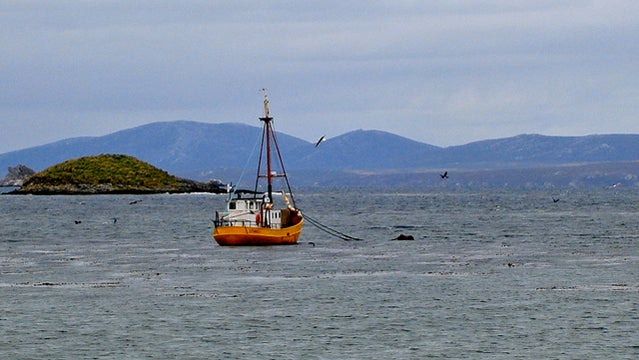The little plane landed on an almost flat spot—avoiding the jutting rocks—on Carcass Island, a small island in northwest Falklands. Rob McGill, who owns the island, met us. In his 70s, with white hair and a ruddy face, he loaded the four of us and our gear into the Land Rover, and we headed out on a two-track through rocky, rough terrain. “I know where all the rocks are,” he said. “Because I’ve hit every one of them.”
Albatross
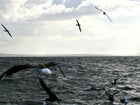 Albatross.
Albatross.Steeple Jason
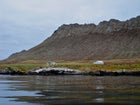 Steeple Jason.
Steeple Jason.Black-browed albatross
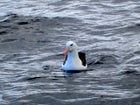 Black-browed albatross.
Black-browed albatross.Johnny Rooks
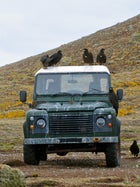 Johnny Rooks.
Johnny Rooks.After a kidney-minding ride up and over a rocky hill we jolted down to the water where Carcass House sat behind a windbreak of thick, house-high cedar (or something that looked like cedar) trees. A couple of Johnny Rooks—the local name for the endangered striated caracara—sat in the five foot wide front lawn.
I had come to stay at the Carcass House and explore Carcass, but over tea in the dining room I found out the other passengers were taking the bright yellow sailboat anchored in the harbor to Steeple Jason to count birds. This is the most remote island in the Falklands, and is home to the largest colony of albatross in the world—about half a million birds. I casually said I’d love to go and the next thing I knew I was throwing on as many layers as I could find and the staff was loading me up with snack food. Within minutes I was on a 10-hour roundtrip voyage with a stop at the island to off-load gear and the researchers.
Steeple Jason is owned by the . (Someone named Jason used to own a couple of islands in this area and the “steeple” comes from the dramatic profile of this particular island.) There’s a research station on the island that can sleep up to 10 people. No one lives on Steeple Jason and there are no sheep or human-introduced predators like cats and rats, which is good news for the nesting birds.
is doing the bird survey—led by an Australian named Al. The other guy, Andy, was an Englishman with a Ph.D. in Ornithology (he studied black-backed gulls that were living in a dump near his university), who is married to a woman doing a teaching stint in the Falklands. Andy watches his kids and does various jobs—tour guide to Bluff Point, working for South Georgia fisheries, jobs for Falklands Conservation. Andy ran the Falkland Island marathon a week or so before I met him and the Argentines took the top three spots in the women’s division and the second or third spot in the men’s. As tensions between Argentina and the Falkland Islands builds, these wins didn’t make the islanders happy.
The third survey crewmember was Drew, a 14-year-old kid with red hair and an eye for birds. He was very soft-spoken and spent hours scanning the water with his binoculars excitedly pointing out all the unusual birds—the royal albatross, and all the wandering albatross (he counted 52 of them on the way over) in among the hundreds of black-browed albatross.
I tried to talk to Drew about the 10,000-year-old skeleton of the extinct Falkland Islands wolf (warrah) he found last year. “Did you think it was a dog’s skeleton?” I asked. “No,” he replied. “Did you know it was something special?” I continued. “Yes,” he said, and I could see that he was praying that I would shut the hell up so he could get back to some serious birding.
Michael Clarke owns the Condor. She’s 50 feet overall with a wheelhouse, a cabin with benches on each side, and a table down the middle (there’s a little galley in the corner), and a bunkhouse down below. She’s a steel boat painted orange on the inside and bright yellow on the outside. Although the Condor is a sailboat, Michael never uses the sail, which is cracked and tied to the boom. It’s a practical, functional boat that does well in the unpredictable South Atlantic waters. Michael wears a ripped raincoat mended with duct tape over blue coveralls. His cousin, Derek, is helping him out. I recognized him as a pilot from an earlier flight I had in the Falklands. He sails with Michael whenever he gets the chance.
The boat pitches and rolls most of the way to Steeple Jason. During a stretch of open water between islands, waves break over the bow. It’s overcast with a little wind and I finally go into the cabin because it was getting hard to hold onto the rail. I guess now I know for sure that I don’t get seasick. Al had to go below decks to sleep. We saw rafts of albatross, giant petrels, fulmers, shags, and rockhopper and gentoo penguins. We passed a rocky islet covered with fur seals.
The research station is near one end of Steeple Jason, the opposite side of the island as the albatross colony. We anchored the Condor at the mouth of a little cove—both sides of the entrance were low rock cliffs covered with gentoo penguins and shags. An inflatable boat was lowered from the stern and we filled it with the gear and ourselves then motored ashore. We had to climb slick rocks carrying the gear to reach the house. Fortunately, tussock grasses grew among the rocks, giving me something to grab on to else I would have been in the water.
The house—only a couple of years old—was a sturdy box from Scandinavia, where they know how to build shelters to withstand rough conditions. While the researchers settled in, Derek and Michael went to the outbuilding to fire up the Land Rover so Derek could drive me near the albatross colony. Johnny Rooks were everywhere, flying and hopping behind us like a bunch of big Labrador puppies. When we stopped the jeep a dozen of the hawk-sized birds got onto the roof and hood. We made our way through the tussock bog trying to wedge our feet between the knee-high root clumps with grasses growing from them reaching several feet above our heads. I just kept an eye on Derek’s red jacket as he tried to blaze a trail. Sometimes we had to go over the clumps when we couldn’t force our feet between them.
You could hear and smell the birds before spotting them. We were sneaking up on a tiny part of the enormous colony. At the edge of the bog hundreds of young black-browed albatross sat on foot-high nests that looked like stovepipes coming out of the ground. Most had already lost their downy feathers but were not yet ready to fledge. They clacked their long bills and mewled and called.
Young non-breeding adults—like teenagers—gathered at the outskirts of the colony, looking gawky and clearly checking out the competition. Adults were flying in with food. One did a clumsy crash-landing against a rock in front of us, for while they are graceful on the wing they are hopelessly clumsy on land.
These beautiful sleek-looking white birds with narrow, sooty black wings have a seven-foot span that makes them look like gliders as they skim along the ocean in search of food. They can live up to 70 years. The lovely black line that highlights their eyes reminds me of the eyes of an Italian model who went a bit heavy on the liner.
In between the albatross nests sat young rockhopper penguins—the kind of penguin with the long yellow droopy eyebrow feathers. Rockhoppers have long claws on the end of their feet that help them scale cliffs so you find these little penguins nesting in the most amazing places.
Michael, Derek, and I headed back to the Condor just as the light was beginning to fade. As we pulled the anchor I looked back at Steeple Jason in time to see Al, Andy, and Drew walking toward the albatross colony followed by the inquisitive Johnny Rooks. And as we headed back into the choppy sea, I wondered, how exactly do you count half a million birds?


